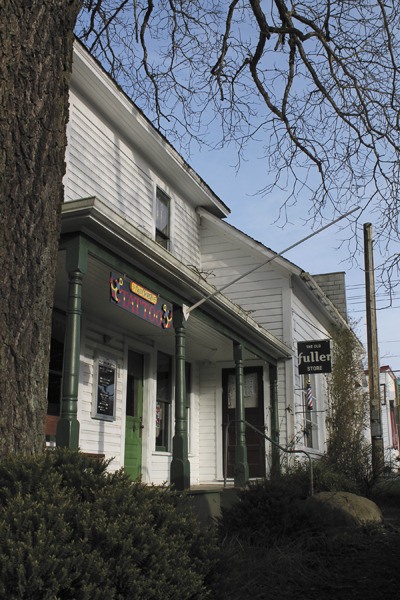The Fuller Store, the oldest commercial building on Vashon, could become the island’s 16th landmarked structure should the King County Landmarks Commission approve the nomination at its March 26 meeting.
Roy McMakin and Mike Jacobs nominated their property, a two-story, wood-frame structure at the crossroads in Center, last month. The designation would also protect the two black walnut trees in front of the structure, towering trees thought to be more than 100 years old.
Julie Koler, who heads King County’s preservation office, said she was thrilled by the nomination.
“It’s a gem,” she said of the property. “It’s a gem in its rarity, materials, association, everything.”
McMakin, reached Thursday, said he and Jacobs have long wanted to get the building designated as historic. McMakin and Jacobs are the fourth owners of the building since it was built in 1884, a structure that McMakin called “insanely intact.”
“I feel that it’s our responsibility to do what we can to preserve it because it’s one of the more historic buildings in all of King County,” he said.
The store, which currently houses Sea Change Tattoo and some private offices, would have been protected as a historic structure had an effort to make Center a historic district won approval.
When that effort unraveled last fall, McMakin said, he and Jacobs decided to move forward with a nomination on their own.
“Mike and I were always intending to get it designated,” McMakin said of the Fuller Store.
Molly Reed, who heads Vashon Allied Arts and who opposed the historic district nomination for Center, said she was glad to see McMakin move forward on a designation for his own building.
“I think it’s terrific,” she said. “It had always been our opinion that that was the one structure in the proposed district that had maintained its integrity over all these years and probably should be designated.”
The issue of whether Center should become a historic district became mired in controversy last year, in part because some saw the proposal — put forward by islander Duane Dietz — as an effort to derail VAA’s ambitious plans to build a 20,000-square-foot performing arts center at the crossroads. Ultimately, Dietz withdrew his nomination effort.
But before he did so, a lawyer for VAA challenged the ordinance the county uses to designate structures as historic, saying the county had been misreading its own law.
That ordinance, crafted 30 years ago and modeled after a federal law used by the National Park Service, lists several aspects of historic integrity a building or district needs to possess — including design, setting, materials and workmanship — before it can be designated. The county had maintained that not every aspect needed to be met. But last fall, after VAA’s challenges, lawyers for the county said the ordinance should be redrafted to ensure it was solid.
The county is currently working to revise its historic designation ordinance to allow designations for properties that don’t meet every aspect of integrity, Koler said, and several nominations are pending until the redraft is complete. But the county can move forward with the Fuller Store nomination because the property is one of the few in the county that does meet all seven criteria.
“It’s rare,” Koler said. “Fewer and fewer meet all seven integrity criteria. … That’s how special this one is.”’
Dietz, a landscape architect and historic preservationist, wrote the nomination for the Fuller Store and recounted the history of what is the oldest commercial building sill standing on the island.
When it was built by George and Hattie Fuller in 1884, it was only one story measuring 18 by 25 feet and was located at Tramp Harbor, where it became the island’s second store, he said. The next year, the Fullers moved the store to Center and added the attached single home on the south side of the building.
From 1886 to 1915, it was used as a meat market, bakery and barber shop, Dietz noted in his report. In 1921, the building was sold in a foreclosure sale to Otto Therkelsen, who used it as a garage and workshop for his berry trucking business, transporting strawberries and currants to fruit-processers. The false front parapet — a “boomtown” facade, Dietz said — was likely added in 1926, when the road was widened.
Since 1972, the building has been in continuous retail use — housing an antique shop, a book store, a wine shop, a bakery and today a tattoo parlor and barber shop.
The building’s unadorned style speaks to the early commercial times on the island, Dietz said. Its significance is also found in its setting, Dietz noted. Several other historic buildings are found at that intersection, he said in his report, making it “the oldest visually intact rural commercial crossroads on Vashon and perhaps in King County.”
“That these buildings still exist today,” he added, “is a testament to the generations of owners who have maintained the historic character of this intersection.”
McMakin said he feels confident that the historic designation will be approved by the Landmarks Commission when it meets later this month. He’s glad to be bringing the nomination forward.
“It feels like the right thing to do,” he said.
The Landmarks Commission will hold a public hearing to review the Fuller Store’s nomination at 4:30 p.m. Tuesday, March 26, at King Street Center, 201 S. Jackson, in Seattle.



